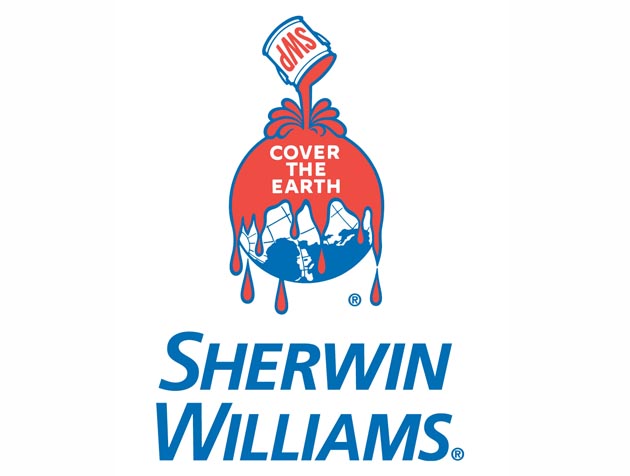
Sherwin Williams' logo.
This story was produced by FairWarning, a Los Angeles-based nonprofit news organization focused on public health and safety issues.
In April, based on new toxicity estimates, the US Centers for Disease Control and Prevention raised to 535,000 its estimate of the number of children with potentially dangerous levels of lead in their blood. But the communities trying to tackle the problem may not see another cent from what some public officials say is the prime culprit: the manufacturers of lead pigments whose products infuse the flaking paint still found in millions of American dwellings. The lead paint industry may, in fact, be on the verge of defeating the last major legal assault by municipalities and states seeking damages to pay for lead removal.
Some experts had expected such lawsuits to follow the path of tobacco litigation during the 1990s, when states wrested a $248 billion settlement from cigarette makers to cover smoking-related health costs. “My prediction was that lead would be the next big toxic tort litigation,” says Jed Ferdinand III, a Connecticut lawyer who is familiar with the issue. “That really hasn’t happened.”
Indeed, apart from one settlement, the industry has successfully fended off roughly 50 lawsuits by states, cities, counties, and school districts over the past quarter century. Now, in a trial under way in San Jose, California, industry lawyers are seeking a final victory in a case brought by 10 agencies, including the cities of San Francisco, Oakland, and San Diego, and the counties of Los Angeles and Santa Clara. The agencies want the industry to cover the cost of eliminating lead paint from all the homes in their jurisdictions; the price tag could exceed $1 billion.
The industry has prevailed in past cases despite evidence that executives knew more than a century ago that lead paint is hazardous, yet audaciously promoted it as healthful: In 1923, an ad in National Geographic from lead pigment maker National Lead (now NL Industries) proclaimed: “Lead helps to guard your health.” The next year, an ad from a unit of paint maker Sherwin-Williams boasted: “Cousin Susie says her health improved instantly” after her home was covered with lead paint.
Lead, which has plenty of industrial uses, is sometimes found in drinking water due to old lead pipes. For decades, it was used as a gasoline additive for cars, and private planes, shockingly, still use leaded gas. It’s present in most solder and bullets, and children’s products are regularly recalled for lead—prominent examples in recent years have included play jewelry and the wildly popular Thomas & Friends trains. But federal authorities say the biggest lingering public health threat comes from lead-laden house paint. Lead pigments were mixed into paint for decades, not merely for color, but also because they made the paint more durable and washable.
The federal government outlawed lead paint for household use in 1978 due to its health hazards, but it is still found on the walls and trim of old houses and apartments, where young children can ingest it as it chips off walls and gets ground into dust. Roughly 35 percent of all American homes have some lead paint, and 22 percent have significant lead-paint hazards, according to a 2011 survey by the Department of Housing and Urban Development.
Public health authorities have made great strides in combating lead poisoning. But recent research has found that even small amounts of the metal can be harmful, which prompted federal authorities this year to more than triple their estimate of the number of children at risk. Young children with elevated lead levels are at risk of lower IQ, attention disorders, and other problems related to brain damage. (In “America’s Real Criminal Element: Lead,” Kevin Drum draws intriguing connections between leaded gas and criminal behavior.)
Although some tenants have won settlements against their landlords for lead poisoning, lawsuits brought by public agencies against lead-pigment makers have yielded only one success: In July 2005, DuPont agreed to pay $12.5 million to resolve a case brought by Rhode Island, which accused the industry of creating a public nuisance and presented internal documents showing that executives had long been aware of the hazards. The next year the state won $2.4 billion for lead abatement after a four-month trial against the remaining defendants, but the Rhode Island Supreme Court overturned the decision in 2008.
The lawsuits have failed for various reasons. For individual plaintiffs with lead-related health claims, it has been tough to prove that lead paint from their dwelling was the source. Similarly, public agencies have been unable to show definitively which companies manufactured the lead pigment used in a specific building or neighborhood—the courts have rejected efforts to assign liability according to the market shares of the various players. “Without product identification,” the Missouri Supreme Court ruled in 2007 in a case brought against the industry by St. Louis, “the city can do no more than show that the defendants’ lead paint may have been present in the properties where the city claims to have incurred abatement costs. That risks exposing these defendants to liability greater than their responsibility and may allow the actual wrongdoer to escape liability entirely.”
Other government suits have been thrown out when judges ruled that the public nuisance laws under which they were filed did not apply—the lead paint was deemed a threat to individuals in their private homes, but not to the community as a whole. “However grave the problem of lead poisoning is in Rhode Island, public nuisance law simply does not provide a remedy for this harm,” noted the Rhode Island Supreme Court when it overturned the state’s victory.
But after some marathon pretrial battles, the California case was allowed to proceed under the state’s somewhat broader public nuisance law. It is only the third public lead-pigment case to go to trial since 1989, when New York City officials pioneered the litigation, only to have their claims dismissed before getting to the trial phase. Indeed, presiding Judge James P. Kleinberg of Santa Clara County Superior Court has urged the California parties to settle.
The defendants in the case include Sherwin-Williams, one of the nation’s biggest paint producers, and DuPont, one of the world’s largest chemical companies—whose 2012 revenues were $9.5 billion and $35 billion, respectively. (Also ARCO, now a BP subsidiary; ConAgra Grocery Products; and NL Industries, formerly National Lead Co.)
Defense lawyers have argued in a brief that the companies weren’t aware when they promoted lead paint that it would someday cause harm. “Scientific knowledge concerning lead exposure evolved over the decades,” it reads. What’s more, they claim there is no longer any widespread danger from lead. Today’s blood lead levels, according to their court filings, do not present “a current public health crisis” but rather “a public health success story.”
What’s more, they argue, California already has a well-funded lead poisoning prevention program that collects annual fees primarily from the gasoline industry, but also from makers of paint and other lead-containing products.
The lawsuit, initiated 13 years ago, has dragged on for so long that Kleinberg is the third judge to handle it. It was dismissed in 2003, but revived three years later by California’s 6th District Court of Appeals, which reinstated the public nuisance claim. “Where such a ‘ticking time bomb’ exists,” the court wrote, “the public should not have to wait for the destructive results before taking action.”
The government’s difficulties in securing lead cleanup money from the industry was presaged by private lawsuits, including a landmark case known as Santiago v. Sherwin-Williams Company. The plaintiff, Monica Santiago, was born in November 1972 and lived until 1978 in a Boston apartment full of lead paint. She was diagnosed with lead poisoning as a one-year-old, after allegedly ingesting paint from the unit’s walls. When she was three, Santiago’s medical condition dramatically worsened, and she underwent chelation therapy, in which a lead-binding chemical is injected into the bloodstream to help the patient’s body excrete the metal.
In 1987, Santiago sued Sherwin-Williams, NL Industries, and others, claiming they caused her lead poisoning, which later led to hyperactivity-attention disorder and motor skills difficulties. She sought $2.5 million in compensatory and punitive damages. In 1992 a federal court in Boston rejected the case. Her appeal also failed.
Santiago’s attorney, Neil Leifer, had taken her case after discovering documents in the National Archives pointing to the industry’s early knowledge of the poisonous nature of lead. Those documents, and others discovered later, have been used against the industry ever since. A Sherwin-Williams newsletter from 1900, for example, described lead as a “deadly cumulative poison.”
In 1904, Sherwin-Williams published an article in a company magazine saying that lead was “poisonous in a large degree, both for workmen and for the inhabitants of a house.”
And as early as 1912, documents show, National Lead excluded women and children from working with lead because of its known dangers, yet continued to manufacture it for use in homes.
Donald E. Scott, one of the defense lawyers in the California case, points out that these early documents “describe lead-poisoning in workplace settings, like factories, from people consuming very large amounts of lead,” rather than household settings. Doctors, he says, spent many decades afterward trying to establish the toxic threshold for lead.
But 1950s letters from the now-defunct Lead Industries Association signaled that industry officials were well aware of dangers of their product at that time. “With us, childhood lead poisoning is common enough to constitute perhaps my major ‘headache,'” Manfred Bowditch, health and safety director for the association, wrote in 1955.
Bowditch elaborated on that point in a letter the next year to Felix E. Wormser, assistant secretary for the Department of the Interior, which was responsible for regulating mining and metal industries: “Aside from the kids that are poisoned (and we still don’t know how many there are), it’s a serious problem from the viewpoint of adverse publicity. The basic solution is to get rid of our slums, but even Uncle Sam can’t seem to swing that one. Next in importance is to educate the parents, but most of the cases are in Negro and Puerto Rican families, and how does one tackle that job?”
In 1960, at the Lead Industries Association annual meeting, a report by secretary-treasurer Robert L. Ziegfeld outlined concerns about lead poisoning. “The toxicity of lead poses a problem that other nonferrous industries generally do not have to face. Lead poisoning, or the threat of it, hurts our business in several different ways.”
“In the first place,” Ziegfeld went on, “it means thousands of items of unfavorable publicity every year. This is particularly true since most cases of lead poisoning today are in children, and anything sad that happens to a child is meat for newspaper editors and is gobbled up by the public. It makes no difference that it is essentially a problem of slums, a public welfare problem. Just the same the publicity hits us where it hurts.”
Scott, the industry lawyer, calls the references to slums and minorities, “callous and regrettable.” But he adds that some of the same documents show the industry was working hard to help children in the affected communities.
The California plaintiffs will continue to present their case this week. The trial is expected to continue through late August, at least.










